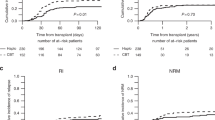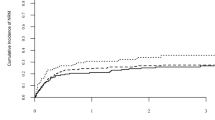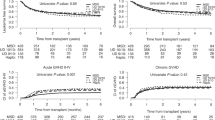Abstract
Allogeneic HSCT is a curative treatment for high-risk leukemia. In Europe, approximately 15% of children have an HLA-matched sibling, but in 65–70% HLA allele-matched (9–10/10) unrelated donors (UD) can be identified. Transplantation using an HLA partially mismatched donor, unrelated cord blood or haploidentical family donor with graft manipulation is then considered with preference on the basis of local experience and/or availability. Here we evaluate the outcomes of 87 consecutive patients with leukemia transplanted with unmanipulated graft from matched or partially mismatched UD or cord blood (CB) at our institution between January 2001 and December 2007. Within the median follow-up of 30 months, the acute GVHD grade II was diagnosed in 70.9% patients; grades III–IV only in 4.6%. The overall incidence of chronic GVHD was 43.3% (extensive in 34.9%). The probability of 3-year EFS was 59.5% and that of 3-year overall survival was 66.9%. TRM at day +100 was 4.5%, and overall it was 13.8%. Fourteen patients (16.1%) died as a consequence of post-transplant leukemia relapse. We conclude that the prognosis of patients transplanted for leukemia using unmanipulated grafts from HLA-matched or partially mismatched UD or CB is comparable and satisfactory. TRM and relapse rate are lower than in the earlier period.
This is a preview of subscription content, access via your institution
Access options
Subscribe to this journal
Receive 12 print issues and online access
$259.00 per year
only $21.58 per issue
Buy this article
- Purchase on Springer Link
- Instant access to full article PDF
Prices may be subject to local taxes which are calculated during checkout



Similar content being viewed by others
References
Miano M, Labopin M, Hartmann O, Angelucci E, Cornish J, Gluckman E et al. Haematopoietic stem cell transplantation trends in children over the last three decades: a survey by the paediatric diseases working party of the European Group for Blood and Marrow Transplantation. Bone Marrow Transplant 2007; 39: 89–99.
Klingebiel T, Handgretinger R, Lang P, Bader P, Niethammer D . Haploidentical transplantation for acute lymphoblastic leukemia in childhood. Blood Rev 2004; 18: 181–192.
Lang P, Greil J, Bader P, Handgretinger R, Klingebiel T, Schumm M et al. Long-term outcome after haploidentical stem cell transplantation in children. Blood Cells Mol Dis 2004; 33: 281–287.
Dey BR, Spitzer TR . Current status of haploidentical stem cell transplantation. Br J Haematol 2006; 135: 423–437.
Beck JF, Klingebiel T, Kreyenberg H, Schaudt A, Wolle W, Niethammer D et al. Relapse of childhood ALL, AML and MDS after allogeneic stem cell transplantation can be prevented by donor lymphocyte infusion in a critical stage of increasing mixed chimerism. Klin Padiatr 2002; 214: 201–205.
Sanchez J, Serrano J, Gomez P, Martinez F, Martin C, Madero L et al. Clinical value of immunological monitoring of minimal residual disease in acute lymphoblastic leukaemia after allogeneic transplantation. Br J Haematol 2002; 116: 686–694.
Yoshimi A, Bader P, Matthes-Martin S, Stary J, Sedlacek P, Duffner U et al. Donor leukocyte infusion after hematopoietic stem cell transplantation in patients with juvenile myelomonocytic leukemia. Leukemia 2005; 19: 971–977.
Petersdorf EW . Risk assessment in haematopoietic stem cell transplantation: histocompatibility. Best Pract Res Clin Haematol 2007; 20: 155–170.
Arcese W, Rocha V, Labopin M, Sanz G, Iori AP, de Lima M et al. Unrelated cord blood transplants in adults with hematologic malignancies. Haematologica 2006; 91: 223–230.
Wall DA, Carter SL, Kernan NA, Kapoor N, Kamani NR, Brochstein JA et al. Busulfan/melphalan/antithymocyte globulin followed by unrelated donor cord blood transplantation for treatment of infant leukemia and leukemia in young children: the Cord Blood Transplantation study (COBLT) experience. Biol Blood Marrow Transplant 2005; 11: 637–646.
Parkman R, Cohen G, Carter SL, Weinberg KI, Masinsin B, Guinan E et al. Successful immune reconstitution decreases leukemic relapse and improves survival in recipients of unrelated cord blood transplantation. Biol Blood Marrow Transplant 2006; 12: 919–927.
Barker JN . Who should get cord blood transplants? Biol Blood Marrow Transplant 2007; 13 (Suppl 1): 78–82.
Teshima T, Matsuo K, Matsue K, Kawano F, Taniguchi S, Hara M et al. Impact of human leucocyte antigen mismatch on graft-versus-host disease and graft failure after reduced intensity conditioning allogeneic haematopoietic stem cell transplantation from related donors. Br J Haematol 2005; 130: 575–587.
Sramkova L, Muzikova K, Fronkova E, Krejci O, Sedlacek P, Formankova R et al. Detectable minimal residual disease before allogeneic hematopoietic stem cell transplantation predicts extremely poor prognosis in children with acute lymphoblastic leukemia. Pediatr Blood Cancer 2007; 48: 93–100.
Acknowledgements
This study was partially supported by VZ MZCR 64203 and 23736.
Author information
Authors and Affiliations
Corresponding author
Rights and permissions
About this article
Cite this article
Sedlacek, P., Mejstrikova, E., Formankova, R. et al. Allo-SCT in children with high-risk leukemia using unmanipulated grafts from alternative donors. Bone Marrow Transplant 42 (Suppl 2), S10–S15 (2008). https://doi.org/10.1038/bmt.2008.277
Published:
Issue Date:
DOI: https://doi.org/10.1038/bmt.2008.277
Keywords
This article is cited by
-
Idarubicin-intensified haploidentical HSCT with GvHD prophylaxis of ATG and basiliximab provides comparable results to sibling donors in high-risk acute leukemia
Bone Marrow Transplantation (2017)
-
Access to allogeneic hematopoietic SCT for patients with MDS or relapsed AML treated according to protocols of the Dutch Childhood Oncology Group
Bone Marrow Transplantation (2012)



